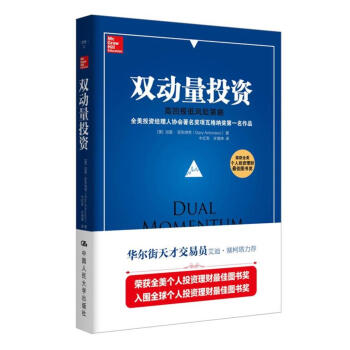![金融衍生品数学模型(第2版) [Mathematical Models of Financial Derivatives Second Edition]](https://pic.tinynews.org/10104519/a7e69a5f-cb76-441a-93a9-d76616fa3e4f.jpg)

具体描述
内容简介
《金融衍生品数学模型(第2版)》旨在运用金融工程方法讲述模型衍生品背后的理论,作为重点介绍了对大多数衍生证券很常用的鞅定价原理。书中还分析了固定收入市场中的大量金融衍生品,强调了定价、对冲及其风险策略。《金融衍生品数学模型(第2版)》从著名的期权定价模型的Black-Scholes-Merton公式开始,讲述衍生品定价模型和利率模型中的最新进展,解决各种形式衍生品定价问题的解析技巧和数值方法。目次:衍生品工具介绍;金融经济和随机计算;期权定价模型;路径依赖期权;美国期权;定价期权的数值方案;利率模型和债券计价;利率衍生品:债券期权、LIBOR和交换产品。内页插图
目录
Preface1 Introduction to Derivative Instruments
1.1 Financial Options and Their Trading Strategies
1.1.1 Trading Strategies Involving Options
1.2 Rational Boundaries for Option Values
1.2.1 Effects of Dividend Payments
1.2.2 Put-Call Parity Relations
1.2.3 Foreign Currency Options
1.3 Forward and Futures Contracts
1.3.1 Values and Prices of Forward Contracts
1.3.2 Relation between Forward and Futures Prices
1.4 Swap Contracts
1.4.1 Interest Rate Swaps
1.4.2 Currency Swaps
1.5 Problems
2 Financial Economics and Stochastic Calculus
2.1 Single Period Securities Models
2.1.1 Dominant Trading Strategies and Linear Pricing Measures
2.1.2 Arbitrage Opportunities and Risk Neutral Probability Measures
2.1.3 Valuation of Contingent Claims
2.1.4 Principles of Binomial Option Pricing Model
2.2 Filtrations, Martingales and Multiperiod Models
2.2.1 Information Structures and Filtrations
2.2.2 Conditional Expectations and Martingales
2.2.3 Stopping Times and Stopped Processes
2.2.4 Multiperiod Securities Models
2.2.5 Multiperiod Binomial Models
2.3 Asset Price Dynamics and Stochastic Processes
2.3.1 Random Walk Models
2.3.2 Brownian Processes
2.4 Stochastic Calculus: Itos Lemma and Girsanovs Theorem
2.4.1 Stochastic Integrals
2.4.2 Itos Lemma and Stochastic Differentials
2.4.3 Itos Processes and Feynman-Kac Representation Formula
2.4.4 Change of Measure: Radon-Nikodym Derivative and Girsanovs Theorem.
2.5 Problems
3 Option Pricing Models: Blaek-Scholes-Merton Formulation
3.1 Black-Scholes-Merton Formulation
3.1.1 Riskless Hedging Principle
3.1.2 Dynamic Replication Strategy
3.1.3 Risk Neutrality Argument
3.2 Martingale Pricing Theory
3.2.1 Equivalent Martingale Measure and Risk Neutral Valuation
3.2.2 Black-Scholes Model Revisited
3.3 Black-Scholes Pricing Formulas and Their Properties
3.3.1 Pricing Formulas for European Options
3.3.2 Comparative Statics
3.4 Extended Option Pricing Models
3.4.1 Options on a Dividend-Paying Asset
3.4.2 Futures Options
3.4.3 Chooser Options
3.4.4 Compound Options
3.4.5 Mertons Model of Risky Debts
3.4.6 Exchange Options
3.4.7 Equity Options with Exchange Rate Risk Exposure
3.5 Beyond the Black-Scholes Pricing Framework
3.5.1 Transaction Costs Models
3.5.2 Jump-Diffusion Models
3.5.3 Implied and Local Volatilities
3.5.4 Stochastic Volatility Models
3.6 Problems
4 Path Dependent Options
4.1 Barrier Options
4.1.1 European Down-and-Out Call Options
4.1.2 Transition Density Function and First Passage Time Density
4.1.3 Options with Double Barriers
4.1.4 Discretely Monitored Barrier Options
4.2 Lookback Options
4.2.1 European Fixed Strike Lookback Options
4.2.2 European Floating Strike Lookback Options
4.2.3 More Exotic Forms of European Lookback Options
4.2.4 Differential Equation Formulation
4.2.5 Discretely Monitored Lookback Options
4.3 Asian Options.
4.3.1 Partial Differential Equation Formulation
4.3.2 Continuously Monitored Geometric Averaging Options
4.3.3 Continuously Monitored Arithmetic Averaging Options
4.3.4 Put-Call Parity and Fixed-Floating Symmetry Relations
4.3.5 Fixed Strike Options with Discrete Geometric Averaging
4.3.6 Fixed Strike Options with Discrete Arithmetic Averaging
4.4 Problems
5 American Options
5.1 Characterization of the Optimal Exercise Boundaries
5.1.1 American Options on an Asset Paying Dividend Yield
5.1.2 Smooth Pasting Condition.
5.1.3 Optimal Exercise Boundary for an American Call
5.1.4 Put-Call Symmetry Relations.
5.1.5 American Call Options on an Asset Paying Single Dividend
5.1.6 One-Dividend and Multidividend American Put Options
5.2 Pricing Formulations of American Option Pricing Models
5.2.1 Linear Complementarity Formulation
5.2.2 Optimal Stopping Problem
5.2.3 Integral Representation of the Early Exercise Premium
5.2.4 American Barrier Options
5.2.5 American Lookback Options
5.3 Analytic Approximation Methods
5.3.1 Compound Option Approximation Method
5.3.2 Numerical Solution of the Integral Equation
5.3.3 Quadratic Approximation Method
5.4 Options with Voluntary Reset Rights
5.4.1 Valuation of the Shout Floor
5.4.2 Reset-Strike Put Options
5.5 Problems
6 Numerical Schemes for Pricing Options
6.1 Lattice Tree Methods
6.1.1 Binomial Model Revisited
6.1.2 Continuous Limits of the Binomial Model
6.1.3 Discrete Dividend Models
6.1.4 Early Exercise Feature and Callable Feature
6.1.5 Trinomial Schemes
6.1.6 Forward Shooting Grid Methods
6.2 Finite Difference Algorithms
6.2.1 Construction of Explicit Schemes
6.2.2 Implicit Schemes and Their Implementation Issues
6.2.3 Front Fixing Method and Point Relaxation Technique
6.2.4 Truncation Errors and Order of Convergence
6.2.5 Numerical Stability and Oscillation Phenomena
6.2.6 Numerical Approximation of Auxiliary Conditions
6.3 Monte Carlo Simulation
6.3.1 Variance Reduction Techniques
6.3.2 Low Discrepancy Sequences
6.3.3 Valuation of American Options
6.4 Problems
7 Interest Rate Models and Bond Pricing
7.1 Bond Prices and Interest Rates
7.1.1 Bond Prices and Yield Curves
7.1.2 Forward Rate Agreement, Bond Forward and Vanilla Swap
7.1.3 Forward Rates and Short Rates
7.1.4 Bond Prices under Deterministic Interest Rates
7.2 One-Factor Short Rate Models
7.2.1 Short Rate Models and Bond Prices
7.2.2 Vasicek Mean Reversion Model
7.2.3 Cox-Ingersoll-Ross Square Root Diffusion Model
7.2.4 Generalized One-Factor Short Rate Models
7.2.5 Calibration to Current Term Structures of Bond Prices
7.3 Multifactor Interest Rate Models
7.3.1 Short Rate/Long Rate Models
7.3.2 Stochastic Volatility Models
7.3.3 Affine Term Structure Models
7.4 Heath-Jarrow-Morton Framework
7.4.1 Forward Rate Drift Condition
7.4.2 Short Rate Processes and Theft Markovian Characterization
7.4.3 Forward LIBOR Processes under Ganssian HIM Framework
7.5 Problems
8 Interest Rate Derivatives: Bond Options, LIBOR and Swap Products
8.1 Forward Measure and Dynamics of Forward Prices
8.1.1 Forward Measure
8.1.2 Pricing of Equity Options under Stochastic Interest Rates
8.1.3 Futures Process and Futures-Forward Price Spreadi
8.2 Bond Options and Range Notes
8.2.1 Options on Discount Bonds and Coupon-Bearing Bonds
8.2.2 Range Notes
8.3 Caps and LIBOR Market Models
8.3.1 Pricing of Caps under Gaussian HJM Framework
8.3.2 Black Formulas and LIBOR Market Models
8.4 Swap Products and Swaptions
8.4.1Forward Swap Rates and Swap Measure
8.4.2 Approximate Pricing of Swaption under Lognormal LIBOR Market Model
8.4.3 Cross-Currency Swaps
8.5 Problems
References
Author Index
Subject Index
前言/序言
In the past three decades, we have witnessed the phenomenal growth in the trading of financial derivatives and structured products in the financial markets around the globe and the surge in research on derivative pricing theory,cading financial institutions are hiring graduates with a science background who can use advanced analyrical and numerical techniques to price financial derivatives and manage portfolio risks, a phenomenon coined as Rocket Science on Wall Street. There are now more than a hundred Master level degreed programs in Financial Engineering/Quantitative Finance/Computational Finance in different continents. This book is written as an introductory textbook on derivative pricing theory for students enrolled in these degree programs. Another audience of the book may include practitioners in quantitative teams in financial institutions who would like to acquire the knowledge of option pricing techniques and explore the new development in pricing models of exotic structured derivatives. The level of mathematics in this book is tailored to readers with preparation at the advanced undergraduate level of science and engineering majors, in particular, basic proficiencies in probability and statistics, differential equations, numerical methods, and mathematical analysis. Advance knowledge in stochastic processes that are relevant to the martingale pricing theory, like stochastic differential calculus and theory of martingale, are introduced in this book.The cornerstones of derivative pricing theory are the Black-Scholes-Merton pricing model and the martingale pricing theory of financial derivatives. The renowned risk neutral valuation principle states that the price of a derivative is given by the expectation of the discounted terminal payoff under the risk neutral measure,in accordance with the property that discounted security prices are martingales under this measure in the financial world of absence of arbitrage opportunities. This second edition presents a substantial revision of the first edition. The new edition presents the theory behind modeling derivatives, with a strong focus on the martingale pricing principle. The continuous time martingale pricing theory is motivated through the analysis of the underlying financial economics principles within a discrete time framework. A wide range of financial derivatives commonly traded in the equity and fixed income markets are analyzed, emphasizing on the aspects of pricing, hedging, and their risk management. Starting from the Black-Scholes-Merton formulation of the option pricing model, readers are guided through the book on the new advances in the state-of-the-art derivative pricing models and interest rate models. Both analytic techniques and numerical methods for solving various types of derivative pricing models are emphasized. A large collection of closed form price formulas of various exotic path dependent equity options (like barrier options, lookback options, Asian options, and American options) and fixed income derivatives are documented.
用户评价
这本书的内容深度和广度都让我印象深刻。作者在数学模型的构建和推导上投入了极大的精力,涵盖了金融衍生品定价、风险管理等多个关键领域。从布莱克-斯科尔斯模型到蒙特卡洛模拟,再到各种更高级的数值方法,书中都进行了深入浅出的阐述。我特别注意到书中对不同模型的适用范围、优缺点以及局限性的分析,这对于实际应用来说至关重要。作者并没有止步于模型本身的介绍,而是着重强调了模型背后的数学原理和金融逻辑,这使得读者不仅能够学会如何使用模型,更能理解其“为什么”而不仅仅是“怎么做”。我曾经在学习某个模型时,对其某些假设条件感到疑惑,但书中对这些假设的讨论,以及对它们可能带来的误差的分析,都给了我非常有价值的启发。这种对细节的关注和对理论深度的挖掘,让我觉得这本书不仅仅是一本教科书,更是一本能够帮助我构建扎实理论基础的宝贵财富。
评分从排版和印刷质量来看,这本书绝对是行业内的佼佼者。纸张的质感非常舒服,触感细腻,而且一点也不透墨,即便是用我常用的钢笔书写,也不会出现晕染的情况。书本的字体大小适中,间距也恰到好处,阅读起来非常舒适,长时间盯着看也不会感到疲劳。书中的图表和公式都清晰地呈现出来,关键的地方还进行了加粗或者不同颜色的标记,这对于我们理解复杂的概念非常有帮助。我特别喜欢书本的装订方式,非常牢固,不会有书页松散的担忧,即便我经常将书本放在背包里携带,它也依然保持着完好的状态。这种用心的制作,让我感受到编著者对作品的尊重,也让我在阅读过程中获得了极佳的体验。
评分这本书的数学严谨性和金融直觉的结合做到了很好的平衡。作者在介绍复杂的数学模型时,并没有忽略其背后的金融意义,而是通过清晰的解释,让读者能够理解模型的逻辑和目的。我曾遇到过一些数学书籍,虽然数学推导非常严谨,但却缺乏金融上的解释,让人难以理解其在金融领域的应用。而《金融衍生品数学模型(第2版)》在这方面做得非常好,它既能满足我对数学严谨性的要求,又能让我深刻理解金融市场的运作机制。书中对各种模型背后假设条件的讨论,以及对这些假设可能带来的偏差的分析,让我受益匪浅。我曾尝试将书中的一些模型应用于实际问题,发现能够有效地解释市场现象,并为投资决策提供支持。
评分我是一位对金融理论和模型感兴趣的学生,一直在寻找一本能够系统性介绍金融衍生品数学模型的书籍。《金融衍生品数学模型(第2版)》无疑是我的不二之选。书中涵盖了从经典模型到前沿方法的广泛内容,并且在讲解过程中,注重理论与实践相结合。例如,书中在介绍某个模型时,会给出相关的应用场景和案例,这让我能够更直观地理解模型的意义和价值。我特别喜欢书中对模型参数校准和数值模拟的讲解,这让我对如何将理论模型应用于实际问题有了更深刻的认识。此外,书中对一些敏感性分析和风险度量方法的介绍,也为我后续的研究方向提供了宝贵的思路。我曾在一位老师的推荐下开始阅读这本书,并且发现它比我之前阅读过的任何一本同类书籍都要全面和深入。
评分这本书的装帧设计给我留下了非常深刻的印象,厚实而有质感的封面,搭配烫金的书名,散发出一种专业而沉稳的气息,让人一看就觉得内容扎实,值得细细品味。书页的纸张也是我非常喜欢的类型,厚度适中,触感细腻,印刷清晰,即使长时间阅读也不会觉得眼睛疲劳。装订方面也非常牢固,感觉可以经受住反复翻阅的考验。在如今快节奏的书籍生产环境中,能够看到一本如此用心制作的书籍,我感到非常欣慰。它不仅仅是一本工具书,更是一件可以陪伴我学习和研究的良伴。我曾购买过一些学术著作,虽然内容可能同样精彩,但粗糙的装帧和印刷质量总是让人在翻阅时略感遗憾。而《金融衍生品数学模型(第2版)》在这方面做得堪称完美,它让我能够更专注于书本内容本身,而不会被外在的细节所干扰。书本的整体尺寸也很适中,既方便放在书架上,又能在桌面进行阅读,不会显得过于庞大而笨重。我甚至会时不时地轻轻摩挲一下封面,感受那种纸张和烫金的质感,这已经成为我学习过程中的一种仪式感。这种对书籍制作细节的关注,也侧面印证了编著者对知识严谨的态度,让我对接下来的阅读充满了期待。
评分我一直对金融衍生品这个领域充满好奇,但又苦于找不到合适的入门材料。市面上充斥着各种各样的书籍,有的过于浅显,流于表面,有的则又太过晦涩,让人望而却步。《金融衍生品数学模型(第2版)》的出现,恰好填补了我的这一空白。它以一种循序渐进的方式,从最基本的概念入手,逐步深入到复杂的模型和应用,完全符合我这种需要系统学习的读者的需求。书中对每一个公式的推导都进行了详尽的解释,对每一个定理的阐述也力求清晰易懂,即使是我这种非数学专业背景的读者,也能基本跟上作者的思路。我尤其欣赏书中在讲解抽象概念时,引入的生动形象的比喻和实际案例,这大大降低了理解的难度,也让枯燥的数学公式变得生动有趣。在学习过程中,我曾遇到过一些困惑,但当我翻阅到书中相应的章节时,往往能找到满意的解答。作者的讲解风格非常具有条理性,逻辑清晰,层次分明,让我能够清晰地把握知识的脉络。这种“润物细无声”的教学方式,是我在其他同类书籍中很少见到的。
评分这本书在数学工具的应用方面做得非常出色。书中不仅介绍了金融衍生品常用的数学概念,如随机过程、偏微分方程等,更详细阐述了如何将这些数学工具应用于实际的模型构建和求解。作者在讲解过程中,并没有回避复杂的数学推导,而是通过清晰的逻辑和细致的步骤,带领读者一步步攻克难关。我尤其欣赏书中关于数值方法的部分,例如有限差分法和蒙特卡洛模拟,这些方法在实际的金融工程中扮演着至关重要的角色。书中对这些方法的算法实现和代码示例(虽然我还没有深入研究)也给了我很大的启发,让我看到了将理论知识转化为实际应用的更多可能性。对于我这样希望深入理解衍生品背后数学机制的读者来说,这本书无疑提供了一个非常好的平台。
评分这本书的内容组织和逻辑结构非常严谨。作者首先从基础的期权理论入手,逐步引入更复杂的衍生品,并在此基础上构建相应的数学模型。章节之间的衔接非常自然,每一部分都承接上一部分的内容,并且为下一部分的内容奠定基础。我尤其欣赏书中对不同模型的比较分析,作者详细阐述了各种模型的适用性、优缺点以及可能存在的局限性,这对于读者在实际应用中进行模型选择具有重要的指导意义。我曾经在学习某个模型时,对其某些假设条件感到疑惑,但书中对这些假设的深入讨论,以及对它们可能带来的误差的分析,都给了我非常有价值的启发。这种对理论深度的挖掘和对细节的关注,让我觉得这本书不仅仅是一本教科书,更是一本能够帮助我构建扎实理论基础的宝贵财富。
评分我是一名金融市场的实践者,平时工作中会接触到各种复杂的衍生品交易。坦白说,我之前对衍生品的理解更多是停留在操作层面,对于其背后的数学原理一直感到模糊。《金融衍生品数学模型(第2版)》的出现,彻底改变了我的看法。书中大量的实例分析和案例研究,让我能够将抽象的数学模型与实际的市场操作紧密联系起来。我发现,很多我之前在实践中遇到的疑难杂症,通过书中介绍的数学工具和分析方法,都能得到清晰的解释和有效的解决方案。例如,书中关于波动率微笑的讨论,以及如何利用期权定价模型来解释和预测这种现象,就让我豁然开朗。我甚至开始尝试利用书中介绍的一些模型,在我的日常工作中进行更精准的风险评估和投资组合优化。这本书不仅提升了我的理论认知,更直接地赋能了我的实践能力,这对我来说意义非凡。
评分从阅读体验上来说,这本书给我带来了极大的满足感。书本的排版设计合理,字体大小和行间距都非常适合长时间阅读。我特别喜欢书中的公式和图表的清晰度,这让我能够准确地理解复杂的数学推导和金融概念。而且,书页的纸张质量也非常好,触感细腻,印刷清晰,即使在光线不足的环境下阅读,也不会感到刺眼。书本的装订也相当牢固,感觉可以经受住反复翻阅的考验,这对于一本经常需要查阅的工具书来说非常重要。我曾购买过一些学术著作,虽然内容可能同样精彩,但粗糙的装帧和印刷质量总是让人在翻阅时略感遗憾。而《金融衍生品数学模型(第2版)》在这方面做得堪称完美,它让我能够更专注于书本内容本身,而不会被外在的细节所干扰。
评分介绍了很多经典的金融数学模型,很有参考价值!
评分好书一本,强烈 金融数学专业的朋友看
评分很好
评分与描述相符,挺好的。
评分很好很快,书很新,不错
评分正品没问题很好
评分金融衍生工具是交易双方通过对利率、汇率、股价等因素变动的趋势的预测,约定在未来某一时间按一定的条件进行交易或选择是否交易的合约。无论是哪一种金融衍生工具,都会影响交易者在未来一段时间内或未来某时间上的现金流,跨期交易的特点十分突出。这就要求交易的双方对利率、汇率、股价等价格因素的未来变动趋势作出判断,而判断的准确与否直接决定了交易者的交易盈亏。
评分讲的很透彻 深入浅出 和一般教材有本质区别
评分讲的很透彻 深入浅出 和一般教材有本质区别
相关图书
本站所有内容均为互联网搜索引擎提供的公开搜索信息,本站不存储任何数据与内容,任何内容与数据均与本站无关,如有需要请联系相关搜索引擎包括但不限于百度,google,bing,sogou 等
© 2025 book.idnshop.cc All Rights Reserved. 静思书屋 版权所有






![《市场赢家生存智慧》丛书:外汇市场技术分析(修订版) [Technical Analysis of the Currency Market] pdf epub mobi 电子书 下载](https://pic.tinynews.org/11375436/rBEhVVLTZewIAAAAAAD_pjaKfnEAAH97QPMb28AAP--089.jpg)













